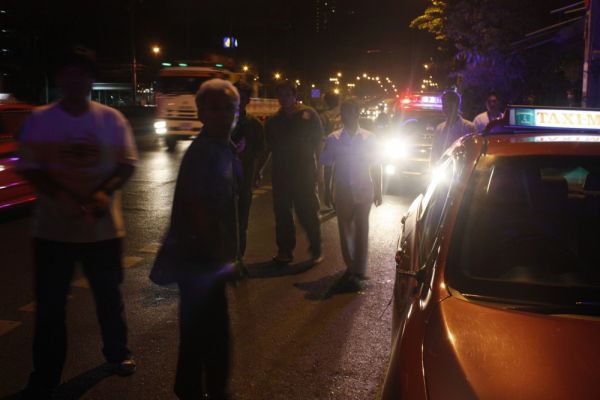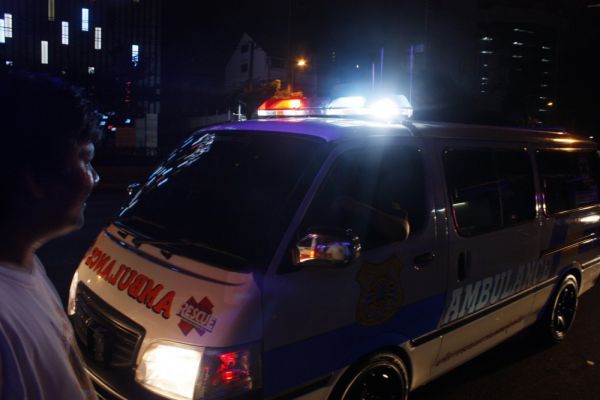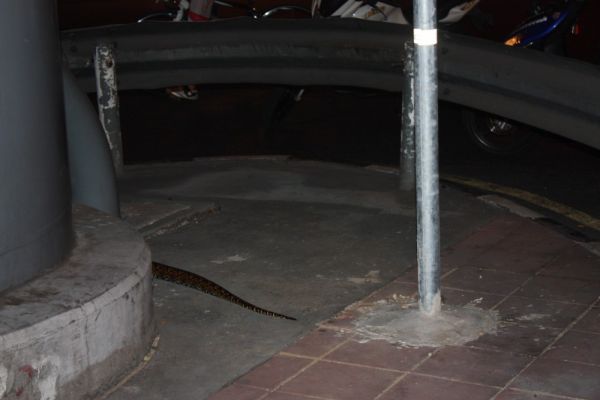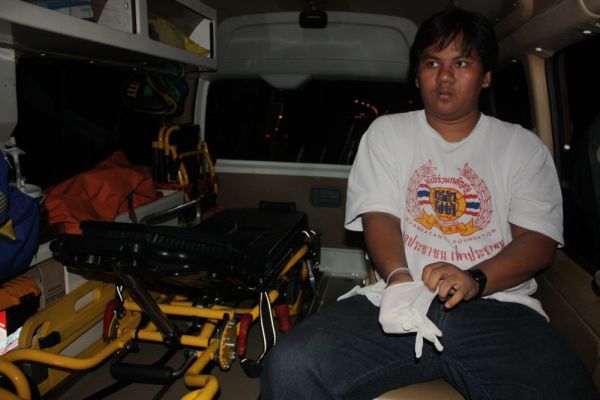The White-Knuckle Nights of Bangkok’s Volunteer Ambulance Squads

Faced with a severe shortage of formal ambulances, Bangkok’s first-responder system is largely informal, made up of volunteers in modified vans and pickup trucks. Photo credit: Witchaya Pruecksamars
Part one of a two-part series. Part two will be posted next week.
It’s 2 a.m. on a Friday night in Bangkok, and the clubs are closing. The city’s fever pitch is now behind it – the pounding beats and colorful lights are dying down; taxis blast through red lights to make quick runs during the golden hour; tall groups of farangs stand next to the stuttering engines of tuk-tuks, negotiating their way back to the hostel; club-goers sober up with chicken rice, warm soup and cold tea. Against this garish late-night backdrop, young volunteers dressed in army-green aviator jumpsuits—the uniform for rescue volunteers—wait for an emergency.
“P’, come quickly!” Nong shouts to me, in a voice that says every second counts. An accident has just been radioed in: A motorcycle ran into a taxi, degree of injury unknown.
It’s our first case since midnight — strangely uneventful for a Friday, say the volunteers. Nong, 19, and his crewmate B, 20, are already at the back of the ambulance, ready to roll. Tui, a full-time medical technician from the Ruam Kayanyu Foundation, takes the wheel. I slide the door shut and sit facing the rear. The ambulance tears off into the night with rapt anticipation mixed with a somber sense of mission—for all we know, somebody might be in agony right now.

B standing in front of the ambulance Lek created out of a van he bought. B’s brother is in the driver’s seat. Photo credit: Witchaya Pruecksamars
These volunteers are known to the world (or at least the internet) as the “body snatchers” of Bangkok. They’ve been valorized by some and demonized by many. But they don’t really care. They simply continue doing what they do, which includes rushing pregnant women to the hospital; storming into burning buildings; cleaning up after shootings, stabbings and suicides; capturing pythons and other urban wildlife; and, most importantly, making sure that accident victims receive proper “pre-hospital” care in this ambulance-starved metropolis.
Bangkok has 150 hospital-operated ambulances for its population of 12 million, less than half of what most cities in more developed countries have. But thankfully, there are more than 4,000 volunteer ambulances: Modified vans and pick-up trucks outfitted with stretchers, providing this megacity with an enormous, informal first-responder system.
The ambulance I’m riding along with isn’t purely volunteer, per se. It’s part of a small fleet of 25 ambulances that the Ruam Katanyu Foundation operates with a mix of paid staff and volunteers. Ruam Katanyu is one of the two big foundations (the other is Poh Teck Tung) acting as umbrella organizations for the city’s volunteer ambulance squads, most of which are supervised by one of the two. The religious institution of Ruam Katanyu was founded half a century ago in the Slaughterhouse area of Klong Toey, one of Bangkok’s largest slums. As a boy, its founder helped carry dead bodies to the morgue when the “iron rain” fell from warplanes during the height of World War II.
It wasn’t until the late 1980s that the state took on more responsibility in providing emergency medical services. State hospitals added emergency rooms, first-responder dispatch centers were established, volunteers were provided more training, financial support was given to providers of emergency services, and so on. But it’s still nowhere near enough. Bangkok continues to rely on the loosely organized, ragtag squadrons of Ruam Katanyu and Poh Teck Tung. Only a decade ago these volunteers had virtually no formal training at all – they learned how to save lives on the job.

A 16-feet-long snake appears at a busy junction. Rescue workers try to capture it before it’s run over, but it manages to slip back down into Bangkok’s subterranean network first. Photo credit: Witchaya Pruecksamars
More developed parts of the world also have charitable ambulance services, but their funding is provided far more formally through official channels. Bangkok’s volunteers are entirely self-funded. Lek, 34, says that over the past ten years he has spent more than two million baht ($60,000 USD) on vehicle modifications, fuel and medical equipment. Most of the equipment is American-made, he notes, so it doesn’t come cheap.
The volunteers have to make their own sacrifices. Lek’s first ambulance, a roofed pick-up truck, was stolen during the height of mega-flood in 2011 when he was away delivering emergency rations in the inundated provinces of Chainat and Ang Thong, just above Bangkok. He took out a five-year loan to buy and modify a second vehicle, a van he turned into a new ambulance.
During the day, Lek works as a clerk in a garment shop in Chinatown. His boss knows about his night job, and is understanding because the work is clearly a personal sacrifice for the good of the city. But his devotion to the volunteer ambulance corps has taken its toll on Lek’s relationships. Girlfriends have left him because of his commitment to the job. He routinely sleeps on the stretcher in the back of his van.
………….
Although Tui is known for his too-fast-too-furious driving skills, the ride is quite smooth. For the patient, good care starts with a smooth ride. A rough one may exacerbate the injury.
We are the first to get to the scene. But by the time we arrive, the injured have already picked themselves up and left. According to the taxi driver, who is throwing a tantrum, the motorcycle lost balance when it broadsided the taxi and its riders hit the ground, their flesh grimly torn across the coarse tarmac for a few meters. Although injured, the motorcyclist and his passenger did not want (or were not able) to compensate the taxi driver for the rear-view mirror they broke off his car. So they fled.
Had the injuries been more severe the volunteers would have needed to assess the situation and make a judgment call as to how to go about the treatment. Their usual method is to “scoop and run” to the hospital. But they would be held accountable if the patient was mishandled and suffered a permanent injury or disability. (This is part of the reason Bangkok’s police force won’t lay a finger on the injured). And so, if the case is more than they can handle or if they don’t have the right equipment – for instance, a defibrillator or a lower-body immobilization device — they can use their handheld radio to issue a Code 7, a request for backup.

B getting ready while the ambulance races to the scene of a Code 40 — a traffic accident. Photo credit: Witchaya Pruecksamars
Effectively, all basic-level emergencies in Bangkok are handled by the volunteer ambulance squads, which form a layer of preliminary “screening” for the formal system, freeing up hospital-based ambulances to be dispatched only in dire scenarios where they are needed most. It also allows formal ambulances to avoid responding to a “one-baht cheap thrill,” the all-too-common prank calls named for the one-baht coin needed to make an emergency call from a phone booth. The formal fleets are too inflexible and stretched too thin for such distractions, so informally operated ambulances are an indispensable filter for such cases.
Bangkok has 48 hospitals that can send out ambulances, but to monitor and provide coverage throughout the whole city 24/7 requires more than that. That’s where the volunteers come in. By congregating at a few hundred staging points — often at police stations, patrol stations, in soi (narrow streets) and alleyways, under flyovers, and anywhere else they can park their vehicles, they form a nimbler, more closely knit network that allows them to respond faster than either the police or a hospital to emergency situations.
These volunteers are much more experienced than they look. Nong has been volunteering since he was fifteen. At the horrific fire at the Santika nightclub that killed 59 New Year’s Eve revelers in 2009, he was there tending to the injured and calming relatives of the dead. B is Nong’s partner. Both of them dropped out of school, but they are financially independent. By day, Nong works at a printing shop and B takes care of an internet game shop.
Then there’s M, B’s identical twin, who rides in Lek’s ambulance as a partner. Whenever Lek needs a nap, M continues listening to the radio scanners. As a driver, Lek needs to rest more than the other volunteers. There’s also Pop, a news cameraman by day whose girlfriend usually tags along on his night shift to make sure that he’s really going out volunteering and not clubbing.
These guys all work under the auspices of the Ruam Katanyu Foundation, their practices and behaviors supervised by their seniors and peers, whom often share a thicker-than-blood bond that keeps them cohesive.
Thousands of volunteers nationwide have formally registered with the National Institute for Emergency Medicine (established in 2008), but there are tens of thousands more who have not. People like Nong, B, M, Lek and Pop – guys who regularly put in 40 to 60 hours of work every week — are not registered, because to do so they would need to be officially endorsed by their foundation. But the big foundations like Ruam Katanyu won’t do that, because they have a “slot” system whereby someone who has already been endorsed needs to quit first to make room for newcomers. Which is to say, in Bangkok, your ambulance driver’s link to the formal medical system may be nearly nonexistent.
………….
Why do they do it? Most of them would say right out that it “comes from the heart,” but I’m not satisfied with that answer.
“The feeling of having saved someone’s life is priceless,” a mother of two told the Bangkok Post, recalling an occasion when she and her teammates took turns administering CPR to a young man until he came back to life.
“They get restless whenever they have free time,” says Lt. Jomdej, who is now pursuing a PhD in criminology. He implies that the volunteers would rather be out in the field than at home watching TV, fighting mosquitoes and boredom while tending to their fellow neighbors in distress. “It’s like an addiction – an addiction to do good.”
For the volunteers, there’s no rest.









